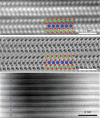Two-dimensional superconducting MoSi2N4(MoN)4n homologous compounds
- PMID: 39104911
- PMCID: PMC11299712
- DOI: 10.1093/nsr/nwac273
Two-dimensional superconducting MoSi2N4(MoN)4n homologous compounds
Abstract
The number and stacking order of layers are two important degrees of freedom that can modulate the properties of 2D van der Waals (vdW) materials. However, the layers' structures are essentially limited to the known layered 3D vdW materials. Recently, a new 2D vdW material, MoSi2N4, without known 3D counterparts, was synthesized by passivating the surface dangling bonds of non-layered 2D molybdenum nitride with elemental silicon, whose monolayer can be viewed as a monolayer MoN (-N-Mo-N-) sandwiched between two Si-N layers. This unique sandwich structure endows the MoSi2N4 monolayer with many fascinating properties and intriguing applications, and the surface-passivating growth method creates the possibility of tuning the layer's structure of 2D vdW materials. Here we synthesized a series of MoSi2N4(MoN)4n structures confined in the matrix of multilayer MoSi2N4. These super-thick monolayers are the homologous compounds of MoSi2N4, which can be viewed as multilayer MoN (Mo4n+1N4n+2) sandwiched between two Si-N layers. First-principles calculations show that MoSi2N4(MoN)4 monolayers have much higher Young's modulus than MoN, which is attributed to the strong Si-N bonds on the surface. Importantly, different from the semiconducting nature of the MoSi2N4 monolayer, the MoSi2N4(MoN)4 monolayer is identified as a superconductor with a transition temperature of 9.02 K. The discovery of MoSi2N4(MoN)4n structures not only expands the family of 2D materials but also brings a new degree of freedom to tailor the structure of 2D vdW materials, which may lead to unexpected novel properties and applications.
Keywords: 2D layered materials; MoSi2N4; homologous compounds; iDPC-STEM; superconductivity.
© The Author(s) 2022. Published by Oxford University Press on behalf of China Science Publishing & Media Ltd.
Conflict of interest statement
None declared.
Figures




Similar articles
-
Chemical vapor deposition of layered two-dimensional MoSi2N4 materials.Science. 2020 Aug 7;369(6504):670-674. doi: 10.1126/science.abb7023. Science. 2020. PMID: 32764066
-
Modulating the electronic properties and band alignments of the arsenene/MoSi2N4 van der Waals heterostructure via applying strain and electric field.Phys Chem Chem Phys. 2023 Dec 13;25(48):33023-33030. doi: 10.1039/d3cp04877b. Phys Chem Chem Phys. 2023. PMID: 38032541
-
Unusually high thermal conductivity in suspended monolayer MoSi2N4.Nat Commun. 2024 Jun 6;15(1):4832. doi: 10.1038/s41467-024-48888-9. Nat Commun. 2024. PMID: 38844447 Free PMC article.
-
Two-Dimensional MoSi2N4 Family: Progress and Perspectives Form Theory.J Phys Chem Lett. 2024 Oct 17;15(41):10284-10294. doi: 10.1021/acs.jpclett.4c02452. Epub 2024 Oct 3. J Phys Chem Lett. 2024. PMID: 39361969 Review.
-
Tuning and exploiting interlayer coupling in two-dimensional van der Waals heterostructures.Rep Prog Phys. 2023 Oct 20;86(11). doi: 10.1088/1361-6633/acfe89. Rep Prog Phys. 2023. PMID: 37774692 Review.
References
LinkOut - more resources
Full Text Sources
